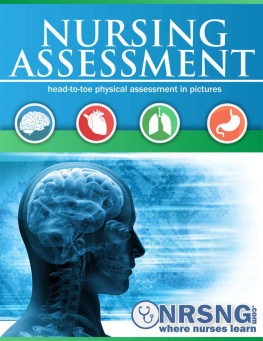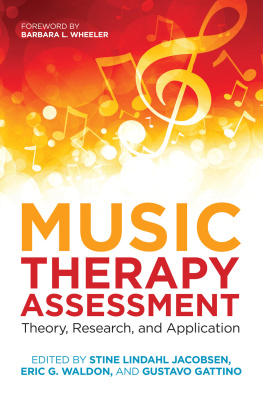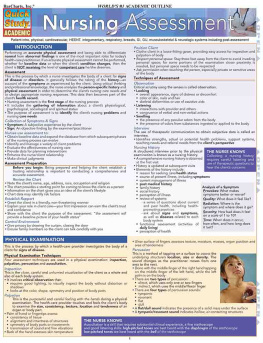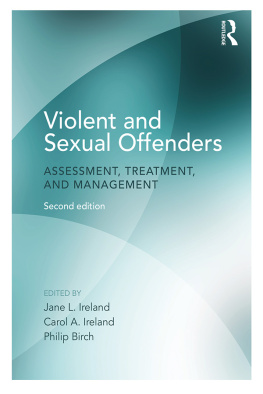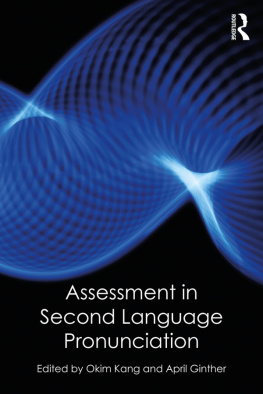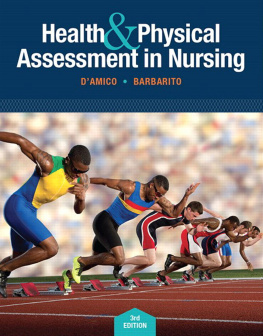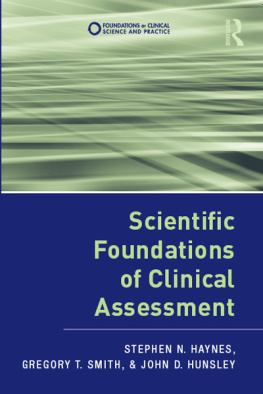Haws - Nursing Assessment: Head-to-Toe Assessment in Pictures
Here you can read online Haws - Nursing Assessment: Head-to-Toe Assessment in Pictures full text of the book (entire story) in english for free. Download pdf and epub, get meaning, cover and reviews about this ebook. year: 2015, publisher: NRSNG.com, genre: Home and family. Description of the work, (preface) as well as reviews are available. Best literature library LitArk.com created for fans of good reading and offers a wide selection of genres:
Romance novel
Science fiction
Adventure
Detective
Science
History
Home and family
Prose
Art
Politics
Computer
Non-fiction
Religion
Business
Children
Humor
Choose a favorite category and find really read worthwhile books. Enjoy immersion in the world of imagination, feel the emotions of the characters or learn something new for yourself, make an fascinating discovery.
- Book:Nursing Assessment: Head-to-Toe Assessment in Pictures
- Author:
- Publisher:NRSNG.com
- Genre:
- Year:2015
- Rating:4 / 5
- Favourites:Add to favourites
- Your mark:
- 80
- 1
- 2
- 3
- 4
- 5
Nursing Assessment: Head-to-Toe Assessment in Pictures: summary, description and annotation
We offer to read an annotation, description, summary or preface (depends on what the author of the book "Nursing Assessment: Head-to-Toe Assessment in Pictures" wrote himself). If you haven't found the necessary information about the book — write in the comments, we will try to find it.
Haws: author's other books
Who wrote Nursing Assessment: Head-to-Toe Assessment in Pictures? Find out the surname, the name of the author of the book and a list of all author's works by series.
Nursing Assessment: Head-to-Toe Assessment in Pictures — read online for free the complete book (whole text) full work
Below is the text of the book, divided by pages. System saving the place of the last page read, allows you to conveniently read the book "Nursing Assessment: Head-to-Toe Assessment in Pictures" online for free, without having to search again every time where you left off. Put a bookmark, and you can go to the page where you finished reading at any time.
Font size:
Interval:
Bookmark:
Medicine and nursing are continuously changing practices. The author and publisher have reviewed all information in this book with resources believed to be reliable and accurate and have made every effort to provide information that is up to date with best practices at the time of publication. Despite our best efforts we cannot disregard the possibility of human error and continual changes in best practices the author, publisher, and any other party involved in the production of this work can warrant that the information contained herein is complete or fully accurate. The author, publisher, and all other parties involved in this work disclaim all responsibility from any errors contained within this work and from the results from the use of this information. Readers are encouraged to check all information in this book with institutional guidelines, other sources, and up to date information. For up to date disclaimer information please visit: http://www.nrsng.com/about.
NCLEX, NCLEX-RN are registered trademarks of the National Council of State Boards of Nursing, INC. and hold no affiliation or support of this product.
All Rights Reserved. No part of this publication may be reproduced in any form or by any means, including scanning, photocopying, or otherwise without prior written permission of the copyright holder. This book is intended for entertainment purposes only and does not imply legal, medical, financial or other professional advice. The reader should seek the help of a competent professional for all matters.
Photo Credits:
All photos are original photos taken or created by the author or rights purchased at Fotolia.com. All rights to appear in this book have been secured. Some image rights were obtained via ECGpedia.com.
Some images within this book are either royalty-free images, used under license from their respective copyright holders, or images that are in the public domain. Images used under a creative commons license are duly attributed, and include a link to the relevant license, as per the author's instructions. All Creative Commons images used under the following license . All works in the public domain are considered public domain given life of the author plus 70 years or more as required by United States law.
Head-to-Toe Physical Assessment in Pictures
NRSNG.com | NursingStudentBooks.com
Jon Haws RN CCRN
Sandra Haws RD CNSC
TazKai LLC 2015, unless where otherwise indicated
First Kindle Edition 2015
No part of this book may be reproduced, scanned, or distributed in any printed or electronic form without permission. Please do not participate in or encourage piracy of copyrighted material.
Your Free Gift!
As a way of saying thanks for your purchase, I'm offering a free PDF download:
63 Must Know NCLEX Labs

With these charts you will be able to take the 63 most important labs with you anywhere you go!
You can download the 4 page PDF document by clicking here, or going to NRSNG.com/labs
Introduction
This book provides the outline for a basic physical assessment. The head to toe assessment is a fundamental skill in nursing practice and allows the nurse to quickly identify abnormalities in the patient.
This is not intended to be a complete guide to pathophysiology but to provide a framework for completing a thorough head to toe assessment.
Learning to efficiently and quickly complete the exam allows the nurse to understand the patient, their needs, and concerns, and allows the nurse the ability to provide the best possible care.
This book is structured in the recommended order for completing the head to toe assessment. Each section contains a short anatomy section followed by an overview of the assessment technique for the given section. This is followed by a small sample of the abnormal findings the nurse may identify for that body system.
The final chapter of the book includes videos, charts, graphs, and website resources to help you in your assessments.
Table of Contents
- General Assessment
- Body Structure/Mobility
- Behavior
- Health History
- Vital Signs
- Height Weight
- Pulse Rate
- Respirations
- Temperature
- Blood Pressure
- Pain
- Integumentary
- Inspect: color, moisture, hair, rashes, lesions, pallor, edema
- Palpate: temperature, turgor, lesions, edema, texture
- Scalp
- Inspect: shape, symmetry
- Palpate: tenderness, deformity
- Nails
- Inspect: shape, color
- Palpate: capillary refill
- Head
- Inspect: symmetry, shape, size, uniformity
- Neck
- Inspect: symmetry, lesions, scars
- Palpate: tenderness, lymph nodes, thyroid gland, TMJ
- Eyes
- Inspect: interior and exterior, visual fields, acuity, reflexes
- Ears
- Inspect: color, shape, symmetry, interior inspection
- Palpate: tenderness, deformity
- Nose
- Inspect: shape, symmetry, interior inspection
- Palpate: frontal sinus, maxillary sinuses
- Mouth and Throat
- Inspect: exterior and interior
- Thorax and Lungs (anterior and posterior)
- Inspection: respiration quality, symmetry, deformity, tracheal location
- Palpation: tenderness, fremitus, chest expansion
- Percussion: percussive tones, diaphragmatic excursion
- Auscultation: breath sounds and quality
- Heart and Great Vessels
- Inspection: jugular venous pulse
- Palpate: pulses, PMI
- Auscultate: heart sounds (bell and diaphragm)
- Peripheral Vascular System
- Inspect: color, edema
- Palpate: temperature, edema
- Abdomen
- Inspect: discomfort, uniformity, color, symmetry, scars, hernia, peristalsis, pulsations
- Auscultate: bowel sounds, bruits
- Percussion: four quadrants, liver, spleen, renal tenderness
- Palpation: light to deep, liver, spleen, aorta, rebound tenderness, fluid wave
- Musculoskeletal
- Inspection: asymmetry, deformity, atrophy
- Palpation: major joints, tenderness, deformity, range of motion
- Neurological
- Inspect: mental status (health history), cranial nerves, coordination, movement, senses
- Palpate: motor strength, muscle tone, reflexes, senses
- Genitourinary
- Inspect: general appearance, lesions, scars
- Palpate: breast exam, testicular exam, prostate exam, vaginal exam, Pap smear
- Lymphatic
- Palpate: assess lymph node locations


The outermost layer of the skin is called the epidermis. The next layer is the dermis and below that is the subcutaneous layer of fat. Several important glands secrete fluids towards the skin. There are two types of sweat glands. The apocrine sweat glands open into the hair follicles. They respond specifically to emotion or arousal. They begin functioning during puberty. The eccrine sweat glands secrete directly to the skin surface. Their main purpose is the regulation of body temperature. The sebaceous glands secrete a lipid substance into hair follicles.
Font size:
Interval:
Bookmark:
Similar books «Nursing Assessment: Head-to-Toe Assessment in Pictures»
Look at similar books to Nursing Assessment: Head-to-Toe Assessment in Pictures. We have selected literature similar in name and meaning in the hope of providing readers with more options to find new, interesting, not yet read works.
Discussion, reviews of the book Nursing Assessment: Head-to-Toe Assessment in Pictures and just readers' own opinions. Leave your comments, write what you think about the work, its meaning or the main characters. Specify what exactly you liked and what you didn't like, and why you think so.

